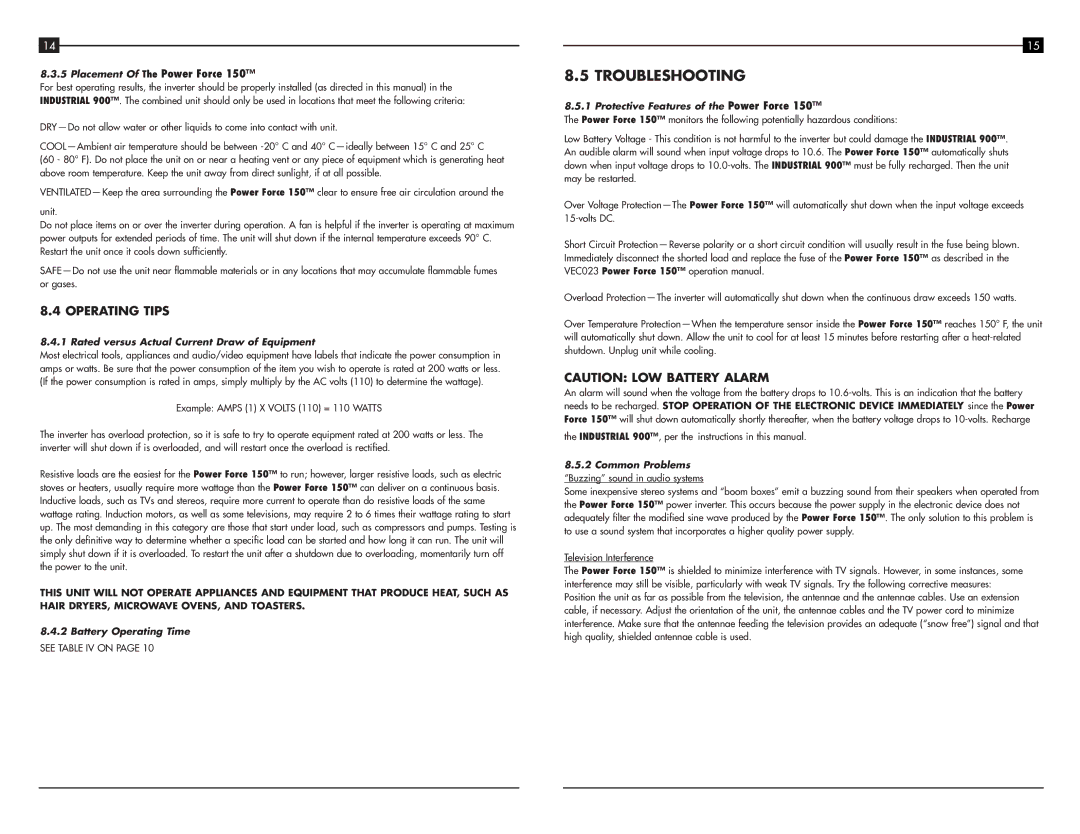
14
8.3.5Placement Of The Power Force 150™
For best operating results, the inverter should be properly installed (as directed in this manual) in the INDUSTRIAL 900™. The combined unit should only be used in locations that meet the following criteria:
(60 - 80° F). Do not place the unit on or near a heating vent or any piece of equipment which is generating heat above room temperature. Keep the unit away from direct sunlight, if at all possible.
unit.
Do not place items on or over the inverter during operation. A fan is helpful if the inverter is operating at maximum power outputs for extended periods of time. The unit will shut down if the internal temperature exceeds 90° C. Restart the unit once it cools down sufficiently.
8.4 OPERATING TIPS
8.4.1 Rated versus Actual Current Draw of Equipment
Most electrical tools, appliances and audio/video equipment have labels that indicate the power consumption in amps or watts. Be sure that the power consumption of the item you wish to operate is rated at 200 watts or less. (If the power consumption is rated in amps, simply multiply by the AC volts (110) to determine the wattage).
Example: AMPS (1) X VOLTS (110) = 110 WATTS
The inverter has overload protection, so it is safe to try to operate equipment rated at 200 watts or less. The inverter will shut down if is overloaded, and will restart once the overload is rectified.
Resistive loads are the easiest for the Power Force 150™ to run; however, larger resistive loads, such as electric stoves or heaters, usually require more wattage than the Power Force 150™ can deliver on a continuous basis. Inductive loads, such as TVs and stereos, require more current to operate than do resistive loads of the same wattage rating. Induction motors, as well as some televisions, may require 2 to 6 times their wattage rating to start up. The most demanding in this category are those that start under load, such as compressors and pumps. Testing is the only definitive way to determine whether a specific load can be started and how long it can run. The unit will simply shut down if it is overloaded. To restart the unit after a shutdown due to overloading, momentarily turn off the power to the unit.
THIS UNIT WILL NOT OPERATE APPLIANCES AND EQUIPMENT THAT PRODUCE HEAT, SUCH AS HAIR DRYERS, MICROWAVE OVENS, AND TOASTERS.
8.4.2Battery Operating Time
SEE TABLE IV ON PAGE 10
15
8.5 TROUBLESHOOTING
8.5.1 Protective Features of the Power Force 150™
The Power Force 150™ monitors the following potentially hazardous conditions:
Low Battery Voltage - This condition is not harmful to the inverter but could damage the INDUSTRIAL 900™. An audible alarm will sound when input voltage drops to 10.6. The Power Force 150™ automatically shuts down when input voltage drops to
Over Voltage
Short Circuit
Overload
Over Temperature
CAUTION: LOW BATTERY ALARM
An alarm will sound when the voltage from the battery drops to
the INDUSTRIAL 900™, per the instructions in this manual.
8.5.2Common Problems “Buzzing” sound in audio systems
Some inexpensive stereo systems and “boom boxes” emit a buzzing sound from their speakers when operated from the Power Force 150™ power inverter. This occurs because the power supply in the electronic device does not adequately filter the modified sine wave produced by the Power Force 150™. The only solution to this problem is to use a sound system that incorporates a higher quality power supply.
Television Interference
The Power Force 150™ is shielded to minimize interference with TV signals. However, in some instances, some interference may still be visible, particularly with weak TV signals. Try the following corrective measures: Position the unit as far as possible from the television, the antennae and the antennae cables. Use an extension cable, if necessary. Adjust the orientation of the unit, the antennae cables and the TV power cord to minimize interference. Make sure that the antennae feeding the television provides an adequate (“snow free”) signal and that high quality, shielded antennae cable is used.
